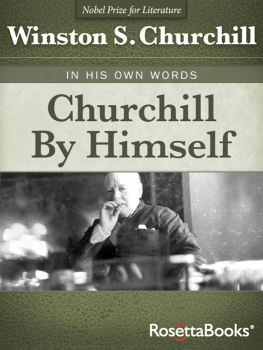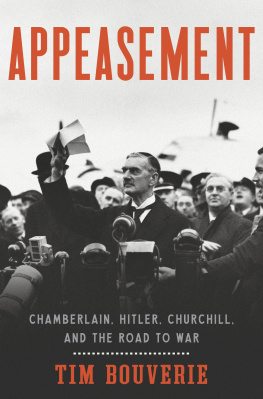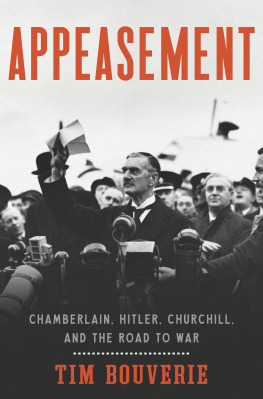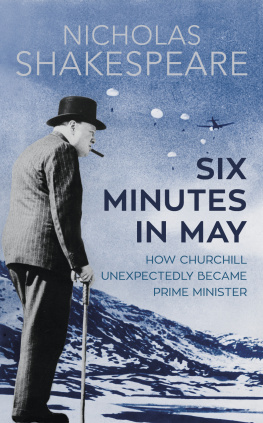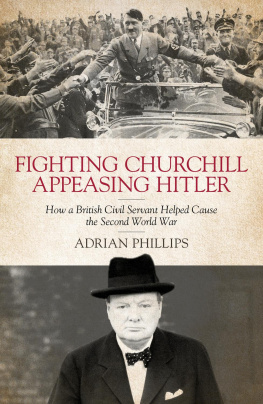Tim Bouverie - Appeasing Hitler: Chamberlain, Churchill and the Road to War
Here you can read online Tim Bouverie - Appeasing Hitler: Chamberlain, Churchill and the Road to War full text of the book (entire story) in english for free. Download pdf and epub, get meaning, cover and reviews about this ebook. year: 2019, publisher: Bodley Head, genre: Non-fiction. Description of the work, (preface) as well as reviews are available. Best literature library LitArk.com created for fans of good reading and offers a wide selection of genres:
Romance novel
Science fiction
Adventure
Detective
Science
History
Home and family
Prose
Art
Politics
Computer
Non-fiction
Religion
Business
Children
Humor
Choose a favorite category and find really read worthwhile books. Enjoy immersion in the world of imagination, feel the emotions of the characters or learn something new for yourself, make an fascinating discovery.

- Book:Appeasing Hitler: Chamberlain, Churchill and the Road to War
- Author:
- Publisher:Bodley Head
- Genre:
- Year:2019
- Rating:3 / 5
- Favourites:Add to favourites
- Your mark:
- 60
- 1
- 2
- 3
- 4
- 5
Appeasing Hitler: Chamberlain, Churchill and the Road to War: summary, description and annotation
We offer to read an annotation, description, summary or preface (depends on what the author of the book "Appeasing Hitler: Chamberlain, Churchill and the Road to War" wrote himself). If you haven't found the necessary information about the book — write in the comments, we will try to find it.
Tim Bouverie: author's other books
Who wrote Appeasing Hitler: Chamberlain, Churchill and the Road to War? Find out the surname, the name of the author of the book and a list of all author's works by series.
Appeasing Hitler: Chamberlain, Churchill and the Road to War — read online for free the complete book (whole text) full work
Below is the text of the book, divided by pages. System saving the place of the last page read, allows you to conveniently read the book "Appeasing Hitler: Chamberlain, Churchill and the Road to War" online for free, without having to search again every time where you left off. Put a bookmark, and you can go to the page where you finished reading at any time.
Font size:
Interval:
Bookmark:


Tim Bouverie read history at Christ Church, Oxford. From 20132017 he was a political journalist at Channel 4 News, where he worked alongside Michael Crick, as his producer, and covered all major political events, including both the 2015 and 2017 General Elections and the EU Referendum. He regularly reviews history and politics books, and has written for the Spectator, Observer and Daily Telegraph. He has also for the last five years worked at the Chalke Valley History Festival as an interviewer.
To my parents, with love and gratitude
. Hitler at Nuremberg, May 1933 (AF Archive/Alamy Stock Photo).
. Nazi boycott of Jewish shops, 1 April 1933 (Hulton Archive/Getty Images).
. Sir Horace Rumbold (Alamy Stock Photo).
. Winston Churchill, September 1938 (Picture Press/Alamy Stock Photo).
. Stanley Baldwin crosses Parliament Square, 7 June 1935 (Popperfoto/Getty Images).
. Anthony Eden at a reception at the Polish Embassy, November 1936 (Keystone-France/Gamma-Rapho/Getty Images).
. Lord Halifax (Margaret Bourke-White/The LIFE Picture Collection/Getty Images).
. Lord Lothian reading Mein Kampf, c.1935 (Keystone/Hulton Archive/Getty Images).
. Hitler with Sir John Simon and Anthony Eden, 25 March 1935 (ullstein bild/Getty Images).
. Viscount Cecil presents three million signatures in support of the International Disarmament Conference, January 1932 (Keystone-France/Gamma-Rapho/Getty Images).
. Haile Selassie appeals to the League of Nations, 30 June 1936 (Everett Collection Historical/Alamy Stock Photo).
. German troops enter the demilitarised Rhineland, 7 March 1936 (Fox Photos/Getty Images).
. Crowds in the Berlin Olympic Stadium, August 1936 (Heinrich Hoffmann/ullstein bild/Getty Images).
. David Lloyd George visits Hitler at the Berghof, 4 September 1936 (World History Archive/Alamy Stock Photo).
. Sir Neville Henderson with Hermann Gring at the Nuremberg Rally (Heinrich Hoffmann/ullstein bild/Getty Images).
. Lord Halifax with Hitler and Neurath at the Berghof, 19 November 1937 (Heinrich Hoffmann/ullstein bild/Getty Images).
. Neville Chamberlain fishing, 8 June 1938 (Keystone/Hulton Archive/Getty Images).
. Chamberlain with Mussolini, September 1938 (Pictorial Press Ltd/Alamy Stock Photo).
. Hitler addresses a crowd in Viennas Heldenplatz, 15 March 1938 (ullstein bild/Getty Images).
. Viennese Jews are forced to scrub the streets after the Anschluss (Heritage Image Partnership Ltd/Alamy Stock Photo).
. Joachim von Ribbentrop leaves the German Embassy in London, 13 March 1938 (Harry Todd/Fox Photos/Getty Images).
. Sir Robert Vansittart and Sir Alexander Cadogan leave Downing Street, 11 September 1938 (H. F. Davis/Topical Press Agency/Hulton Archive/Getty Images).
. Chamberlain prepares to depart Heston airport for his first meeting with Hitler, 15 September 1938 (Imagno/Getty Images).
. Chamberlain with Hitler at the Berghof, 15 September 1938 (Pictorial Press Ltd/Alamy Stock Photo).
. Hitler welcomes Chamberlain at the Hotel Dreesen in Bad Godesberg, 22 September 1938 (Granger Historical Picture Archive/Alamy Stock Photo).
. Trying on gas masks, September 1938 (Keystone-France/Gamma-Rapho/Getty Images).
. The participants of the Munich Conference, 29 September 1938 (World History Archive/Alamy Stock Photo).
. Tribute to Chamberlain at a London florists, 30 September 1938 (Harry Todd/Getty Images).
. Chamberlain at the window of 10 Downing Street, 30 September 1938 (TopFoto).
. Women in the Sudeten town of Eger react to the arrival of German troops, 3 October 1938 (Bettmann/Getty Images).
. Chamberlain inspects the Duces personal bodyguard, 11 January 1939 (ullstein bild/Getty Images).
. German troops enter the grounds of the Hradany Castle in Prague, 15 March 1939 (Granger Historical Picture Archive/Alamy Stock Photo).
. Molotov signs the NaziSoviet Pact, watched by Ribbentrop and Stalin, 23 August 1939 (Corbis/Getty Images).
. German soldiers advance through Polish countryside, 1 September 1939 (Print Collector/Contributor/Getty Images).
. Winston Churchill and Neville Chamberlain, 23 February 1940 (Granger Historical Picture Archive/Alamy Stock Photo).

 Dismemberment of Czechoslovakia: Border Changes, October 1938March 1939
Dismemberment of Czechoslovakia: Border Changes, October 1938March 1939 The desire to avoid a second world war was perhaps the most understandable and universal wish in history. More than 16.5 million people died during the First World War. The British lost 723,000; the French 1.7 million; the Russians 1.8 million; the British Empire 230,000; the Germans over 2 million. Twenty thousand British soldiers died on the first day of the Battle of the Somme, while the ossuary at Douaumont contains the bones of some 130,000 French and German soldiers a mere sixth of those killed during the 302-day Battle of Verdun. Among the survivors there was scarcely a soul that was not affected. Almost everyone had a father, husband, son, brother, cousin, fianc or friend killed or maimed. When it was over, not even the victors could feel victorious. The Cenotaph, unveiled on Whitehall on 19 June 1919, was no Arc de Triomphe but a symbol of loss. Every Armistice Day, thousands of Britons shuffled past it in mournful silence, while, on both sides of the Channel, schools, villages, towns and railway stations commemorated friends and colleagues with their own memorials. In the years that followed the mantra was as consistent as it was determined: Never again!
But it did happen again. Despite the best of intentions and efforts aimed at both conciliation and deterrence, the British and French found themselves at war with the same adversary a mere twenty-one years after the war to end all wars. The purpose of this book is to contribute to our understanding of how this happened.
The debate over appeasement the attempt by Britain and France to avoid war by making reasonable concessions to German and Italian grievances during the 1930s is as enduring as it is contentious. Condemned, on the one hand, as a moral and material disaster, responsible for the deadliest conflict in history, it has also been described as a noble idea, rooted in Christianity, courage and common-sense. Between these two polarities lies a mass of nuance, sub-arguments and historical skirmishes. History is rarely clear-cut, and yet the so-called lessons of the period have been invoked by politicians and pundits, particularly in Britain and the United States, to justify a range of foreign interventions in Korea, Suez, Cuba, Vietnam, the Falklands, Kosovo and Iraq (twice) while, conversely, any attempt to reach an accord with a former antagonist is invariably compared with the infamous 1938 Munich Agreement. When I began researching this book, in the spring of 2016, the spectre of Neville Chamberlain was being invoked by American conservatives as part of their campaign against President Obamas nuclear deal with Iran, while today the concept of appeasement is gaining new currency as the West struggles to respond to Russian revanchism and aggression. A fresh consideration of this policy as it was originally conceived and executed feels, therefore, timely as well as justified.
Next pageFont size:
Interval:
Bookmark:
Similar books «Appeasing Hitler: Chamberlain, Churchill and the Road to War»
Look at similar books to Appeasing Hitler: Chamberlain, Churchill and the Road to War. We have selected literature similar in name and meaning in the hope of providing readers with more options to find new, interesting, not yet read works.
Discussion, reviews of the book Appeasing Hitler: Chamberlain, Churchill and the Road to War and just readers' own opinions. Leave your comments, write what you think about the work, its meaning or the main characters. Specify what exactly you liked and what you didn't like, and why you think so.


